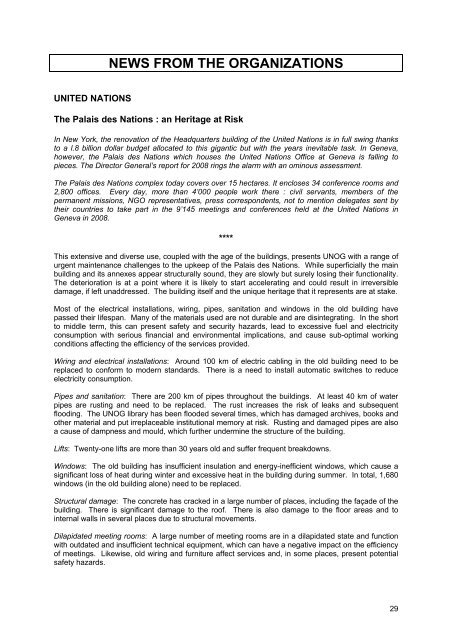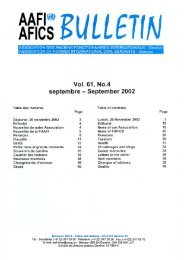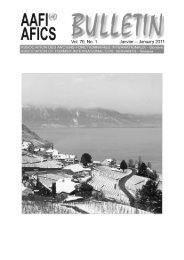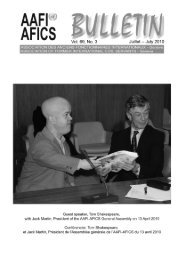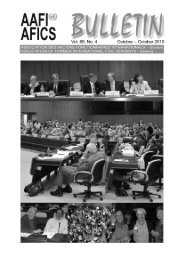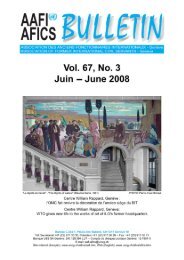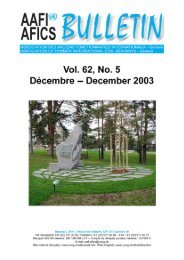pensions - AAFI-AFICS, Geneva - UNOG
pensions - AAFI-AFICS, Geneva - UNOG
pensions - AAFI-AFICS, Geneva - UNOG
- No tags were found...
You also want an ePaper? Increase the reach of your titles
YUMPU automatically turns print PDFs into web optimized ePapers that Google loves.
NEWS FROM THE ORGANIZATIONSUNITED NATIONSThe Palais des Nations : an Heritage at RiskIn New York, the renovation of the Headquarters building of the United Nations is in full swing thanksto a l.8 billion dollar budget allocated to this gigantic but with the years inevitable task. In <strong>Geneva</strong>,however, the Palais des Nations which houses the United Nations Office at <strong>Geneva</strong> is falling topieces. The Director General’s report for 2008 rings the alarm with an ominous assessment.The Palais des Nations complex today covers over 15 hectares. It encloses 34 conference rooms and2,800 offices. Every day, more than 4’000 people work there : civil servants, members of thepermanent missions, NGO representatives, press correspondents, not to mention delegates sent bytheir countries to take part in the 9’145 meetings and conferences held at the United Nations in<strong>Geneva</strong> in 2008.****This extensive and diverse use, coupled with the age of the buildings, presents <strong>UNOG</strong> with a range ofurgent maintenance challenges to the upkeep of the Palais des Nations. While superficially the mainbuilding and its annexes appear structurally sound, they are slowly but surely losing their functionality.The deterioration is at a point where it is likely to start accelerating and could result in irreversibledamage, if left unaddressed. The building itself and the unique heritage that it represents are at stake.Most of the electrical installations, wiring, pipes, sanitation and windows in the old building havepassed their lifespan. Many of the materials used are not durable and are disintegrating. In the shortto middle term, this can present safety and security hazards, lead to excessive fuel and electricityconsumption with serious financial and environmental implications, and cause sub-optimal workingconditions affecting the efficiency of the services provided.Wiring and electrical installations: Around 100 km of electric cabling in the old building need to bereplaced to conform to modern standards. There is a need to install automatic switches to reduceelectricity consumption.Pipes and sanitation: There are 200 km of pipes throughout the buildings. At least 40 km of waterpipes are rusting and need to be replaced. The rust increases the risk of leaks and subsequentflooding. The <strong>UNOG</strong> library has been flooded several times, which has damaged archives, books andother material and put irreplaceable institutional memory at risk. Rusting and damaged pipes are alsoa cause of dampness and mould, which further undermine the structure of the building.Lifts: Twenty-one lifts are more than 30 years old and suffer frequent breakdowns.Windows: The old building has insufficient insulation and energy-inefficient windows, which cause asignificant loss of heat during winter and excessive heat in the building during summer. In total, 1,680windows (in the old building alone) need to be replaced.Structural damage: The concrete has cracked in a large number of places, including the façade of thebuilding. There is significant damage to the roof. There is also damage to the floor areas and tointernal walls in several places due to structural movements.Dilapidated meeting rooms: A large number of meeting rooms are in a dilapidated state and functionwith outdated and insufficient technical equipment, which can have a negative impact on the efficiencyof meetings. Likewise, old wiring and furniture affect services and, in some places, present potentialsafety hazards.29


